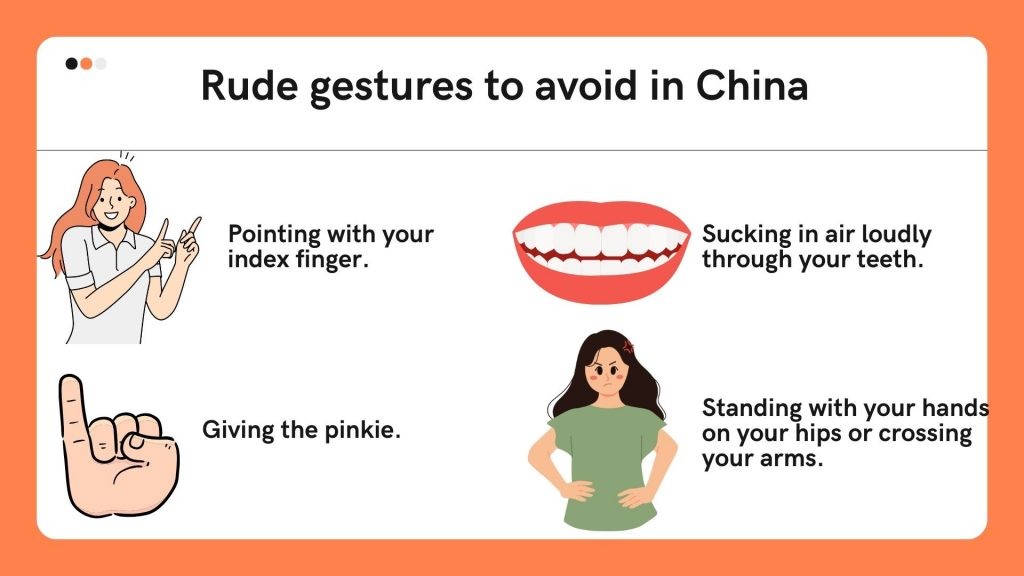When navigating Chinese culture, understanding nonverbal communication is just as important as learning Mandarin. Gestures can significantly influence interactions, and misinterpreting them can lead to misunderstandings or even offense. This guide explores the dos and don’ts of Chinese gestures, with a particular focus on “What Is The Chinese Middle Finger,” along with other key cultural nuances.
Rude Gestures to Avoid in China
Certain gestures considered harmless in Western cultures can be offensive in China. Awareness of these can help avoid awkward or disrespectful situations.
-
Pointing with a Single Finger: Instead of using one finger, gesture with an open palm. Pointing with a single finger is considered rude. Similarly, avoid beckoning someone with your palm up and wiggling your fingers, as this gesture is used for animals and is highly disrespectful.
-
Giving the Pinkie: While not as severe as the middle finger, presenting someone with your pinkie finger can be insulting, implying they are weak or insignificant.
-
The Middle Finger: Just like in Western cultures, extending the middle finger is a highly offensive gesture in China.
-
Loudly Sucking Air Through Teeth: This indicates annoyance or disapproval and is considered impolite.
-
Excessive Hand Movements: Overly dramatic gestures can be seen as disruptive, conveying impatience or annoyance.
-
Winking, Whistling, or Clicking Fingers: These actions can be perceived as disrespectful or flirtatious, especially in professional settings or with unfamiliar individuals.
-
Hands on Hips or Crossed Arms: This stance can convey arrogance or defensiveness.
-
Pointing or Touching with Feet: The feet are considered the “dirtiest” part of the body, so pointing them at someone or touching them with your feet is impolite.
-
Excessive Public Displays of Affection (PDA): While attitudes are evolving, overly affectionate behavior in public is generally frowned upon.
-
Prolonged Eye Contact: Unlike Western cultures, where it signifies confidence, extended eye contact can be interpreted as aggressive or confrontational.
Positive Gestures in China
Understanding positive gestures is equally vital for building rapport and showing respect.
-
Thank You Gesture: Place one palm over a fist, often accompanied by a slight bow.
-
Good Luck Gestures: Women wrap their left hand around their right fist, while men do the opposite, wrapping their right hand around their left fist.
-
Bowing: A slight bow demonstrates respect and humility. The depth and duration depend on the situation and the individuals involved.
-
Handshake: Increasingly common, especially in business settings. Offer a firm but not aggressive grip to convey sincerity.
-
Thumbs Up: Generally seen as a sign of approval and agreement, similar to its use in Western cultures.
Chinese Hand Signs in Context
The meaning of gestures can vary depending on the context. Here are some key areas to consider:
Gestures for Business in China
-
Punctuality: Being on time is crucial.
-
Hierarchical Seating: Understand the seating order based on seniority.
-
Entry Order: The highest-ranking employee usually enters the room first.
-
Proper Titles: Use formal titles until invited to use first names.
-
Avoid Pointing: Use an open palm instead.
-
Two-Handed Exchange: Give and receive items with both hands as a sign of respect.
-
Toasting: Be prepared to participate in toasts, often with alcohol.
Dining Etiquette
-
Punctuality: Arrive on time, or slightly early.
-
Chopstick Placement: Never stick chopsticks upright in a bowl of rice.
-
Avoid Pointing with Chopsticks: Use an open hand gesture instead.
-
Leaving Food: Leaving a small amount of food shows appreciation for the meal.
-
Chopstick Position: Place chopsticks across the top of the rice bowl or on a chopstick holder when finished.
Gift-Giving Gestures
-
Gift Selection: Avoid gifts with negative connotations, such as clocks or items in sets of four.
-
Order of Gifting: Start with the oldest or most senior recipients.
-
Two-Handed Presentation: Offer and receive gifts with both hands.
-
Value of Gifts: Give gifts of comparable value to those you receive.
The Evolution of Chinese Gestures
Chinese gestures have evolved over centuries, influenced by Confucianism, Taoism, and other spiritual traditions. While traditional gestures remain important, modern China has seen the emergence of new gestures influenced by Western culture and digital communication.
What Is The Chinese Middle Finger? History and Context
Yes, the middle finger is considered a rude gesture in Chinese culture. The gesture is nearly universally recognized as offensive.
In ancient China, the middle finger held some significance in spiritual traditions. It was associated with the element of fire and believed to have mystical powers.
Magic, Sorcery and the Middle Finger
In folk beliefs, the gesture involving the middle finger was believed to ward off evil spirits and could be used in rituals or to place curses.
Chinese vs. Western Gestures: Key Differences
-
Eye Contact: Less direct eye contact is preferred in China compared to the West.
-
Facial Expressions: While general expressions are shared, Chinese individuals may be more reserved in expressing emotions.
-
Hand Gestures: Avoid pointing with your finger; use an open palm.
-
Touch: Public displays of affection are less common.
Other Asian Hand Gestures
-
Peace Sign: Common in many Asian countries as a symbol of peace and goodwill.
-
OK Sign: Can have negative connotations in some parts of Asia.
-
Fig Sign: Has various interpretations; may be seen as rude in some regions.
Conclusion
Understanding Chinese gestures is crucial for successful interactions in China. By avoiding rude gestures and embracing positive ones, you can build stronger relationships and navigate social and business settings with confidence.
FAQ
- Is the middle finger rude in China? Yes, it is extremely rude.
- What gestures should I avoid in business? Avoid pointing, crossing your arms, or putting your hands on your hips.
- What should I keep in mind when giving a gift? Avoid inauspicious items and always give and receive with both hands.
- Is it acceptable to use Western gestures? Some are becoming more common, but be mindful of cultural differences.
